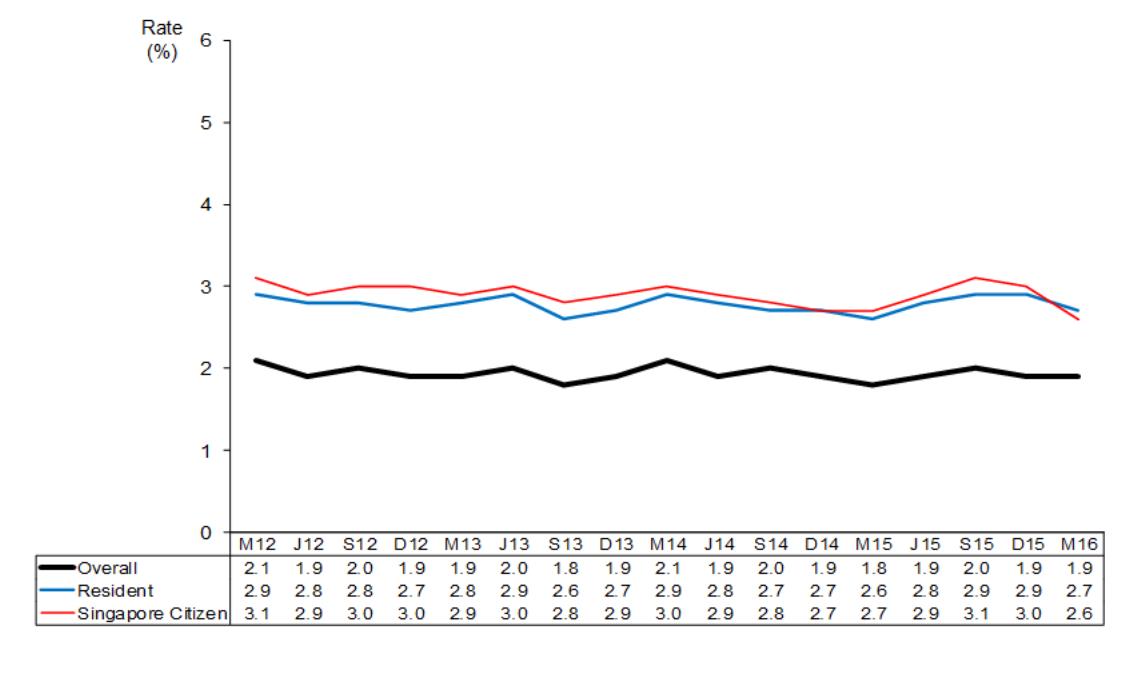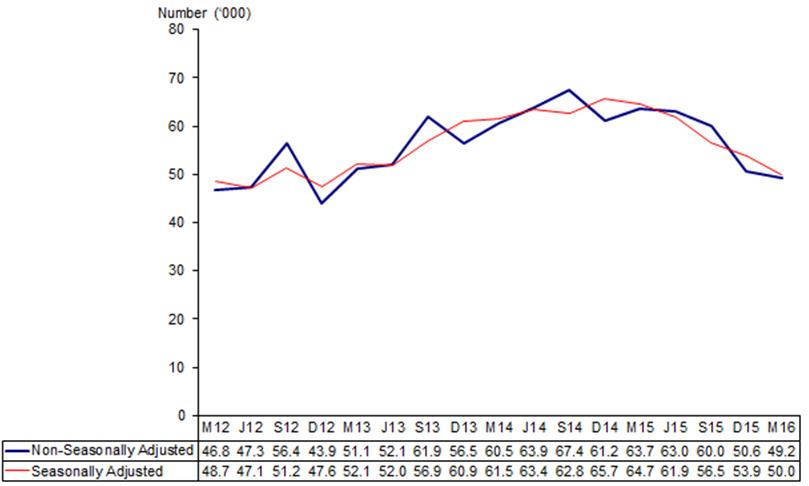Although the report's lower redundancy figures have taken the spotlight, its unemployment and job vacancy figures also have real implications for HR, says one recruitment expert
This week, the Ministry of Manpower (MOM) released its Labour Market First Quarter 2016 Report. Both the mainstream press and the HR trade press led the news with headlines focusing on a reduced amount of redundancies (down from 5,730 in Q4 2015 to 4,710 redundancies in Q1 2016). While this is a positive statistic, there is a wealth of information contained within the report that is also worth commenting on, especially for anyone with an interest in the Singapore recruitment market.
Unemployment
Unemployment, or rather unseasonably adjusted employment, remained unchanged at 1.9%. While this isn’t remarkable in itself, it’s worth highlighting how incredibly low this figure is, especially compared to European countries (the UK’s unemployment rate was 5.1% in March 2016, for instance, according to the UK Office for National Statistics) and in light of a continuously challenging global economic context (such as China's slowdown, the oil price crash and stock market volatility). Singapore’s low unemployment rate is at the forefront of employers’ minds, as the region’s finite working population is regularly encountered during the hiring process.
Also of interest is that the total number of unemployed residents reduced from 64,600 in December 2015 to 60,600 in March 2016.

Source: Labour Force Survey, Manpower Research & Statistics Department, MOM
Job Vacancies
Being a recruiter, I’m obviously very interested in statistics on job vacancies. The non-seasonally adjusted number of job vacancies fell from 50,600 in Q4 2015 to 49,200 in Q1 2016, a fall of 2.8%. Again, this isn’t a surprising statistic in itself considering Q1 for recruitment is always slower. What is more interesting however, is the trend. Job vacancies peaked in September 2014 at 67,400 and since then, there has been a steady decline with a particular significant drop from 60,000 in Q3 2015 to 50,600 in Q4 2015. For the last six months alone, that’s an 18% drop.
This data reflects the existing market sentiment. For the last few months we have been hearing from recruiters and candidates alike that the market has been slower, with an expectation of hiring freezes during 20161.

Source: Labour Market Survey, Manpower Research & Statistics Department, MOM
Ratio of Job Vacancies to Unemployed Workforce
Taking the last two indicators together we can look at how many jobs there are compared to the number of unemployed persons. For every unemployed person there are 1.03 job vacancies. This sounds great and in a perfect world this could mean total employment, but again we can look at the trend, and what we see is a gradual drop in the ratio from 1.42 jobs per unemployed person in July 2015 to 1.03 in March 2016.
This echoes what we have been hearing from candidates, who have expressed concerns that job opportunities have dried up in recent years, and voiced apprehension about the long term effect of a slowing economy on the jobs market2.

Source: Labour Market Survey and Labour Force Survey, Manpower Research & Statistics Department, MOM
So What Does This All Mean?
Well, it appears that the MOM's and the Government's labour policies are having some positive effects for the general workforce, and perhaps this is why the press have been focusing on the redundancy figures. For potential employers and job seekers though the news is not quite so rosy. Indeed, when I meet clients and candidates, eventually the question is asked “what’s the market like at the moment?” At this point, I would share some anecdotal evidence of a candidate heavy market, with number of job vacancies down, particularly at the senior end of the market, but generally this would just be a “feels like” view of the market. However, what this information shows is that the market is getting “tighter”. Quite simply, for employers – there are fewer available candidates around, while for job seekers – there are fewer jobs. As we know, finding the right job, or the right candidate is never easy, so in this more competitive market, you need to be make sure that you are making your best effort by improving your personal or company brand, following best practice and networking both physically and using online social media.
Looking ahead I will be really interested to see what the next quarter’s results will show as Q2 is typically the period when most recruiters enjoy their busiest and most productive months. For Elliott Scott Singapore, we have certainly enjoyed a strong quarter with a number of interesting briefs including several regional heads of HR positions, some of which have been newly created positions with a majority being replacements.
If you found this article of interest, please feel free to share or comment below.
Written by Vincent Romano, managing director of Southeast Asia at Elliott Scott HR
Elliott Scott HR is a global specialist HR recruiter with offices in Dubai, Hong Kong, London, New York, Sao Paulo, Singapore and Tokyo. For more information visit us on LinkedIn, Twitter, Facebook and our website.
1 Singapore headhunters expect hiring freeze in 2016 The Straits Times Online12 Sep 2015
2 Budget 2016: Slowing economy, jobs among Singaporeans' top concerns channelnewsasia.com 22 Mar 2016
Unemployment
Unemployment, or rather unseasonably adjusted employment, remained unchanged at 1.9%. While this isn’t remarkable in itself, it’s worth highlighting how incredibly low this figure is, especially compared to European countries (the UK’s unemployment rate was 5.1% in March 2016, for instance, according to the UK Office for National Statistics) and in light of a continuously challenging global economic context (such as China's slowdown, the oil price crash and stock market volatility). Singapore’s low unemployment rate is at the forefront of employers’ minds, as the region’s finite working population is regularly encountered during the hiring process.
Also of interest is that the total number of unemployed residents reduced from 64,600 in December 2015 to 60,600 in March 2016.

Source: Labour Force Survey, Manpower Research & Statistics Department, MOM
Job Vacancies
Being a recruiter, I’m obviously very interested in statistics on job vacancies. The non-seasonally adjusted number of job vacancies fell from 50,600 in Q4 2015 to 49,200 in Q1 2016, a fall of 2.8%. Again, this isn’t a surprising statistic in itself considering Q1 for recruitment is always slower. What is more interesting however, is the trend. Job vacancies peaked in September 2014 at 67,400 and since then, there has been a steady decline with a particular significant drop from 60,000 in Q3 2015 to 50,600 in Q4 2015. For the last six months alone, that’s an 18% drop.
This data reflects the existing market sentiment. For the last few months we have been hearing from recruiters and candidates alike that the market has been slower, with an expectation of hiring freezes during 20161.

Source: Labour Market Survey, Manpower Research & Statistics Department, MOM
Ratio of Job Vacancies to Unemployed Workforce
Taking the last two indicators together we can look at how many jobs there are compared to the number of unemployed persons. For every unemployed person there are 1.03 job vacancies. This sounds great and in a perfect world this could mean total employment, but again we can look at the trend, and what we see is a gradual drop in the ratio from 1.42 jobs per unemployed person in July 2015 to 1.03 in March 2016.
This echoes what we have been hearing from candidates, who have expressed concerns that job opportunities have dried up in recent years, and voiced apprehension about the long term effect of a slowing economy on the jobs market2.

Source: Labour Market Survey and Labour Force Survey, Manpower Research & Statistics Department, MOM
So What Does This All Mean?
Well, it appears that the MOM's and the Government's labour policies are having some positive effects for the general workforce, and perhaps this is why the press have been focusing on the redundancy figures. For potential employers and job seekers though the news is not quite so rosy. Indeed, when I meet clients and candidates, eventually the question is asked “what’s the market like at the moment?” At this point, I would share some anecdotal evidence of a candidate heavy market, with number of job vacancies down, particularly at the senior end of the market, but generally this would just be a “feels like” view of the market. However, what this information shows is that the market is getting “tighter”. Quite simply, for employers – there are fewer available candidates around, while for job seekers – there are fewer jobs. As we know, finding the right job, or the right candidate is never easy, so in this more competitive market, you need to be make sure that you are making your best effort by improving your personal or company brand, following best practice and networking both physically and using online social media.
Looking ahead I will be really interested to see what the next quarter’s results will show as Q2 is typically the period when most recruiters enjoy their busiest and most productive months. For Elliott Scott Singapore, we have certainly enjoyed a strong quarter with a number of interesting briefs including several regional heads of HR positions, some of which have been newly created positions with a majority being replacements.
If you found this article of interest, please feel free to share or comment below.
Written by Vincent Romano, managing director of Southeast Asia at Elliott Scott HR
Elliott Scott HR is a global specialist HR recruiter with offices in Dubai, Hong Kong, London, New York, Sao Paulo, Singapore and Tokyo. For more information visit us on LinkedIn, Twitter, Facebook and our website.
1 Singapore headhunters expect hiring freeze in 2016 The Straits Times Online12 Sep 2015
2 Budget 2016: Slowing economy, jobs among Singaporeans' top concerns channelnewsasia.com 22 Mar 2016





